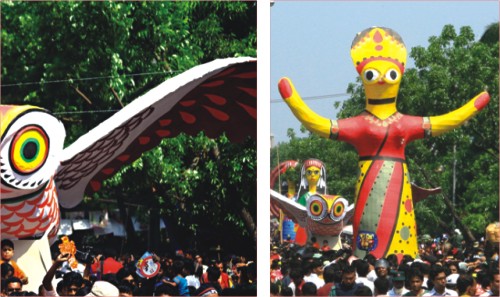| Spotlight
Pahela Baishakh Festivity
IF there is any festival that unites all of us Bangalis, it is none other than the Bengali New Year or Pahela Baishakh. This is a time that enables us to forget all the differences and indulge in celebrating our Bangaliana.

Pahela Baishakh also brings in forefront the everlasting folk songs of this region. Folk songs have recently been even more popularised by singers and musicians like Habib, Ornob, Anushesh and Maksud who have made the young generation once again interested in this genre of music. This week's spotlight is about the revival of folk music in Bangladesh.
Mahdin Mahboob
Star Campus Desk
Photos:
Mustafizur Rahman
The Revival of Folk Music
Elita Karim
THIS is an era when change is being accepted with open arms. The generation is seeking a fresh makeover, a feel-good environment, trendy looks and a rhythmic way of life. That's where the remakes and remixes of our folk numbers come in with a fresh sound and a new appeal.
17-year-old Rashed Hussain is really into the new age frenzy, the loud combination of head banging music and an urge to look, be and feel different. The youthful heart of his tends to look for the bright side of everything in life. One of his everyday habits is listening to music late into the night and trying to hold on to the rhythm. Very recently, however, he discovered a new side to himself. His iPod now lists flute pieces by Chawrasya, fusion by Talvir Singh and the folk-fusion beats of Bangla. “It is an amazing feeling,” says Rashed as he switches on his music system flaunting his new playlists for everyone. “These remixes and remakes of our old folks are what I listen to all the time now.”
To the youngsters, folk music, today, is not only symbolised merely with a dotara and the bangla dhol. Thanks to musicians and bands like Bangla, Habib and the legendary Maqsud ul Haque, today, folk music has been revived. Listening to Anusheh of Bangla sing the heartfelt words to the song Aami opar hoye boshe achi, listeners and music lovers can feel the pain of loneliness and sense the sweetness of solitude. Even today, listening to Zodi bondhu zaibar sao, gharer gamsa thuiya zao re creates the image of one watching her beloved rowing away, fearing and at the same time, accepting the fact that she would have to now wait for nearly an eternity, before her beloved returns to her. This is the beauty of the folk music in Bangladesh. It speaks of the common man and his everyday observations. His daily life is sketched and harmonised into beautiful renditions by folk artists.
Today, these folk songs are presented in a new package by musicians, which actually appeals to youngsters. “Times have changed,” says 23-year-old Shahana, a BBA student doing her final semester in a private university. “Not everyone can be expected to actually listen and at the same time like the folk tastes. In fact, young people today are not even aware of many folk numbers which used to be 'hit numbers' at one time in places like Old Dhaka and other parts of Bangladesh as well.'

When Habib featuring Shireen's album 'Punjabiwala' had hit the stalls, listeners were blown away with the witty lyrics in the album, not to mention the suggestive tones used in accordance with many of the lyrics. These songs, however, are very old, and according to the elderly, the song Punajbiwala was based on a music lover who would put on a red Punjabi and delve into the nights filled with music. Over the years, these songs were almost forgotten and with every new generation, a new genre of music would move a step forward. However, Habib's 'Punjabiwala' took the listeners by storm, not only because of the lyrics, but also his treatment of the music, his mixes of the western and the traditional and also his creation of a complete new aura which gave a new meaning to young listeners.
24-year-old Deepa Matin works in a multinational and has been following the music scene in Bangladesh for years together. She thinks that it is very natural for music tastes to change and listeners to crave for a variety. “This is one of the reasons why sometimes we find folk music slowly disappearing from our collections,” says Deepa. “But these songs are coming back to us again. In way, the remixes and remakes of these age-old songs have made many youngsters dig out the original tracks.”
When the band Bangla came into existence, listeners were introduced to yet another dimension of music in the country. They did rock versions of Lalon numbers and even jazzed them up with their guitar strums and soft rolls of the drums. While their first album 'Kingkortobbobimur' revived many of the old folk melodies, the band's second album ‘Prottutponnomotitto’ was created based on the concept of existence and survival of the fittest in terms of religious justification.

The folk music of our country voices out the pains and joy of our people. Even today, these compositions speak to us about our ancestors, the lovers' woes and God's ways with men. And to add to it all, these folk mixes sound all the more soulful and touching even when they are presented in their new form - simply a slight tweak to the music. |

